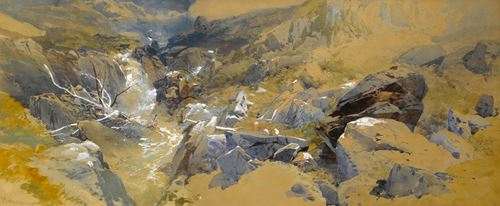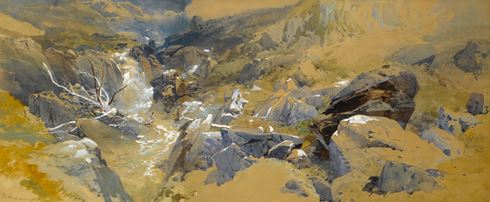
Thomas Miles RICHARDSON, JR.
Newcastle 1813 - Newcastle 1890
Biography
The son of the Newcastle landscape painter of the same name, Thomas Miles Richardson Junior was trained by his father, and was arguably to become even more successful than him. He began his career in his native Newcastle, where he first exhibited his work at the age of fourteen. By the 1830’s his watercolour landscapes were achieving a measure of commercial and critical success, and he was sending his work to be exhibited at the British Institution and the Royal Academy in London. In 1838 he published a large folio of twenty-six plates entitled Sketches on the Continent, a series of views in France, Switzerland, Italy, Germany, Holland, etc. from sketches made during a tour in 1837, with eleven of the plates lithographed by himself. In Newcastle Richardson ran a private art academy together with his elder brother and fellow artist George, but in 1846, three years after being elected an Associate of the Old Water-Colour Society, he decided to settle in London.
In 1851 he became a full member of the OWCS, and from then until his death took part in every summer and winter exhibition of the Society, eventually showing over seven hundred watercolours. Richardson travelled extensively throughout Scotland and the North of England, and also widely in Europe. His exhibited works, often on a panoramic scale, were made up largely of landscapes in the Borders and the Scottish Highlands, Italian views and, in later years, Alpine scenes in Switzerland, France and Italy. As one contemporary writer noted of Richardson, shortly after his death, ‘The history of his life is almost written in the account of his exhibited drawings, nearly all of which are local views, British and foreign, which imply many seasons of sketching both at home and abroad...The works of T. M. Richardson are specially characterized by clever drawing and workmanlike skill in manipulation of material. They are rendered attractive by bright contrasts of colour, and a deftness of handling which is particularly apparent in his sketches…In depicting extensive moorland and other scenes he not unfrequently extends the field of vision laterally by the use of paper of widely oblong proportions.’
Following a few years of poor health, Richardson died in January 1890, and the contents of his studio were dispersed at auction at Christie’s in London in June of that year. A large group of watercolours by the artist is today in the collection of the Laing Art Gallery in Newcastle, while several others are in the Victoria and Albert Museum in London.


